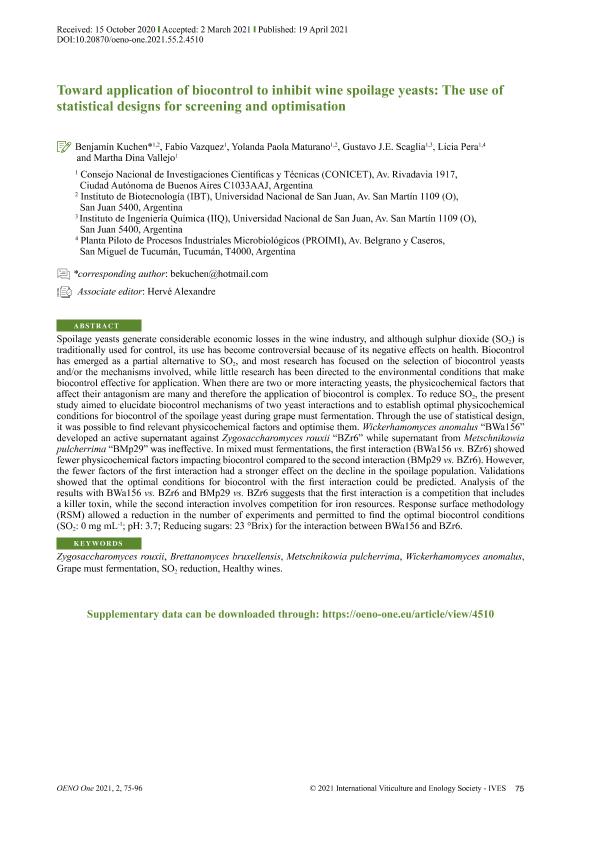Mostrar el registro sencillo del ítem
dc.contributor.author
Kuchen, Benjamín

dc.contributor.author
Vazquez, Fabio

dc.contributor.author
Maturano, Yolanda Paola

dc.contributor.author
Scaglia, Gustavo Juan Eduardo

dc.contributor.author
Pera, Licia Maria

dc.contributor.author
Vallejo, Martha Dina

dc.date.available
2021-06-14T15:34:24Z
dc.date.issued
2021-04
dc.identifier.citation
Kuchen, Benjamín; Vazquez, Fabio; Maturano, Yolanda Paola; Scaglia, Gustavo Juan Eduardo; Pera, Licia Maria; et al.; Toward application of biocontrol to inhibit wine spoilage yeasts: The use of statistical designs for screening and optimisation; Vigne et Vin Publications Internationales; Oeno One; 55; 2; 4-2021; 75-96
dc.identifier.issn
2494-1271
dc.identifier.uri
http://hdl.handle.net/11336/133784
dc.description.abstract
Spoilage yeasts generate considerable economic losses in the wine industry, and although sulphur dioxide (SO2) is traditionally used for control, its use has become controversial because of its negative effects on health. Biocontrol has emerged as a partial alternative to SO2, and most research has focused on the selection of biocontrol yeasts and/or the mechanisms involved, while little research has been directed to the environmental conditions that make biocontrol effective for application. When there are two or more interacting yeasts, the physicochemical factors that affect their antagonism are many and therefore the application of biocontrol is complex. To reduce SO2, the present study aimed to elucidate biocontrol mechanisms of two yeast interactions and to establish optimal physicochemical conditions for biocontrol of the spoilage yeast during grape must fermentation. Through the use of statistical design, it was possible to find relevant physicochemical factors and optimise them. Wickerhamomyces anomalus “BWa156” developed an active supernatant against Zygosaccharomyces rouxii “BZr6” while supernatant from Metschnikowia pulcherrima “BMp29” was ineffective. In mixed must fermentations, the first interaction (BWa156 vs. BZr6) showed fewer physicochemical factors impacting biocontrol compared to the second interaction (BMp29 vs. BZr6). However, the fewer factors of the first interaction had a stronger effect on the decline in the spoilage population. Validations showed that the optimal conditions for biocontrol with the first interaction could be predicted. Analysis of the results with BWa156 vs. BZr6 and BMp29 vs. BZr6 suggests that the first interaction is a competition that includes a killer toxin, while the second interaction involves competition for iron resources. Response surface methodology (RSM) allowed a reduction in the number of experiments and permitted to find the optimal biocontrol conditions (SO2: 0 mg mL-1; pH: 3.7; Reducing sugars: 23 °Brix) for the interaction between BWa156 and BZr6.
dc.format
application/pdf
dc.language.iso
eng
dc.publisher
Vigne et Vin Publications Internationales
dc.rights
info:eu-repo/semantics/openAccess
dc.rights.uri
https://creativecommons.org/licenses/by-nc-sa/2.5/ar/
dc.subject
BRETTANOMYCES BRUXELLENSIS
dc.subject
GRAPE MUST FERMENTATION
dc.subject
HEALTHY WINES
dc.subject
METSCHNIKOWIA PULCHERRIMA
dc.subject
SO2 REDUCTION
dc.subject
WICKERHAMOMYCES ANOMALUS
dc.subject
ZYGOSACCHAROMYCES ROUXII
dc.subject.classification
Ingeniería Química

dc.subject.classification
Ingeniería Química

dc.subject.classification
INGENIERÍAS Y TECNOLOGÍAS

dc.title
Toward application of biocontrol to inhibit wine spoilage yeasts: The use of statistical designs for screening and optimisation
dc.type
info:eu-repo/semantics/article
dc.type
info:ar-repo/semantics/artículo
dc.type
info:eu-repo/semantics/publishedVersion
dc.date.updated
2021-06-10T19:20:22Z
dc.journal.volume
55
dc.journal.number
2
dc.journal.pagination
75-96
dc.journal.pais
Francia

dc.description.fil
Fil: Kuchen, Benjamín. Departamento de Ingenieria Agronomica ; Facultad de Ingenieria ; Universidad Nacional de San Juan; Argentina
dc.description.fil
Fil: Vazquez, Fabio. Universidad Nacional de San Juan; Argentina
dc.description.fil
Fil: Maturano, Yolanda Paola. Departamento de Ingenieria Agronomica ; Facultad de Ingenieria ; Universidad Nacional de San Juan; Argentina
dc.description.fil
Fil: Scaglia, Gustavo Juan Eduardo. Consejo Nacional de Investigaciones Científicas y Técnicas; Argentina. Universidad Nacional de San Juan; Faculta de Ingeniaría; Instituto de Ingeniería Química; Argentina
dc.description.fil
Fil: Pera, Licia Maria. Consejo Nacional de Investigaciones Científicas y Técnicas. Centro Científico Tecnológico Conicet - Tucumán. Planta Piloto de Procesos Industriales Microbiológicos; Argentina
dc.description.fil
Fil: Vallejo, Martha Dina. Universidad Nacional de San Juan; Argentina
dc.journal.title
Oeno One
dc.relation.alternativeid
info:eu-repo/semantics/altIdentifier/url/https://oeno-one.eu/article/view/4510
dc.relation.alternativeid
info:eu-repo/semantics/altIdentifier/doi/http://dx.doi.org/10.20870/oeno-one.2021.55.2.4510
Archivos asociados
